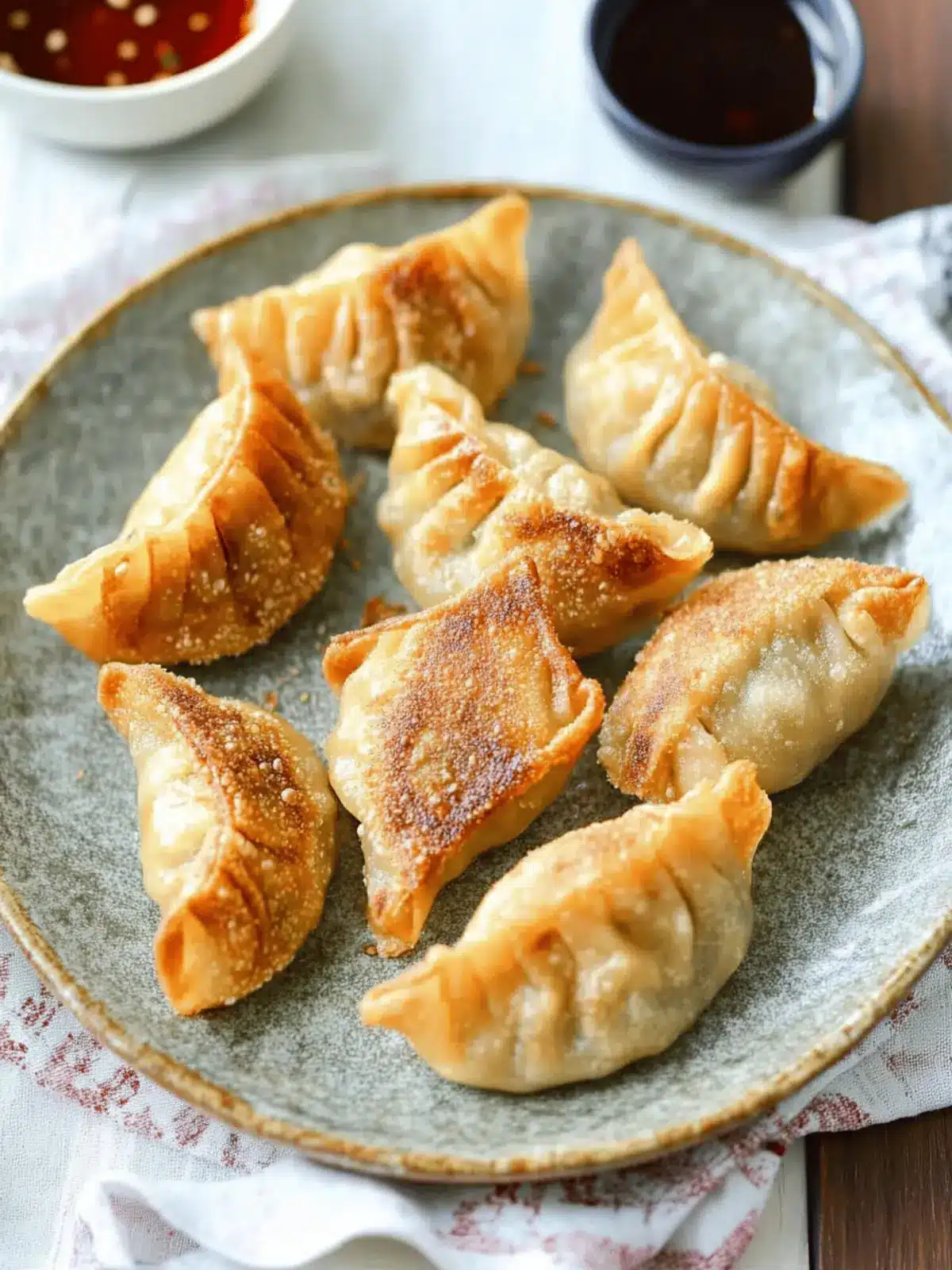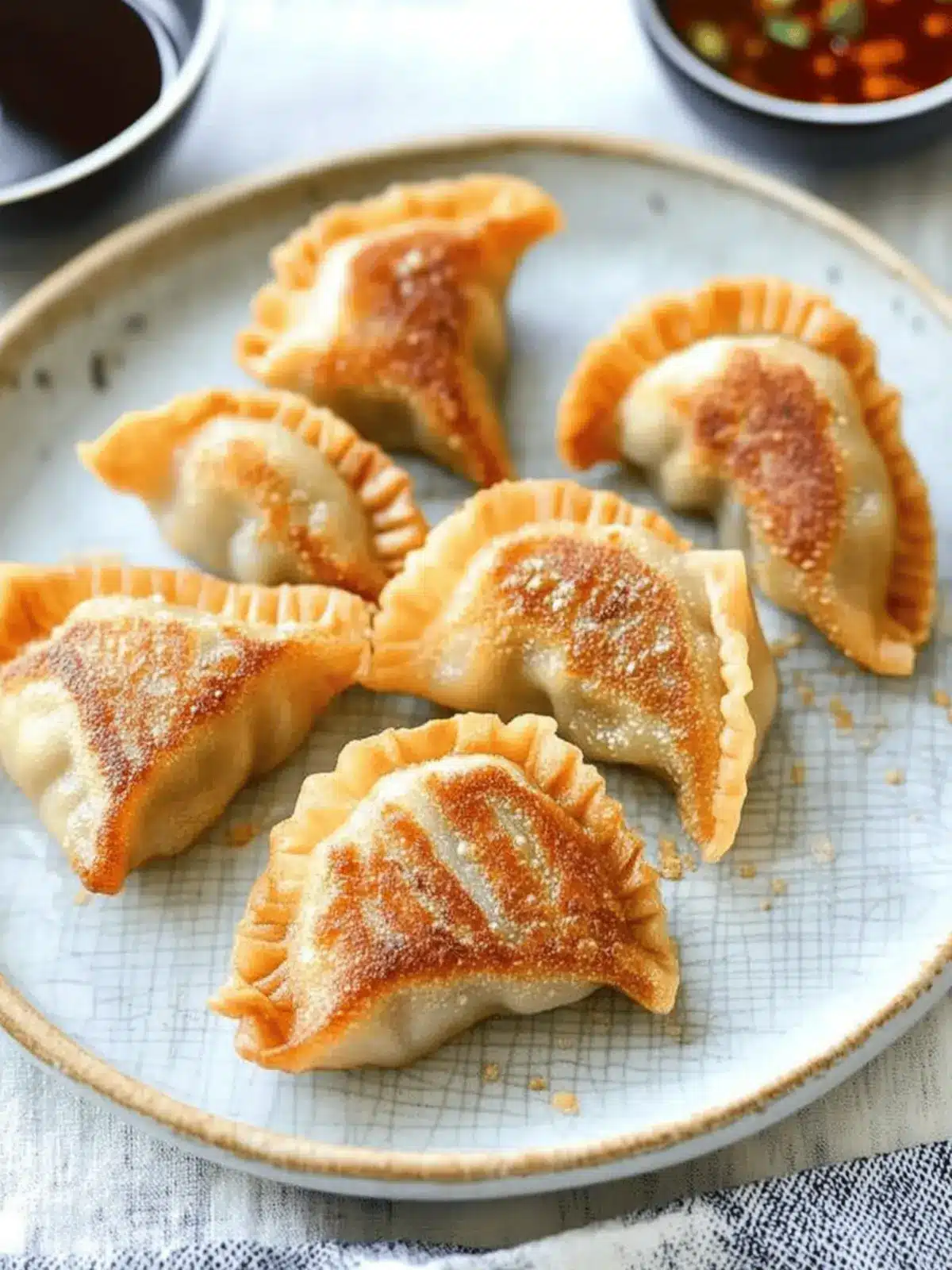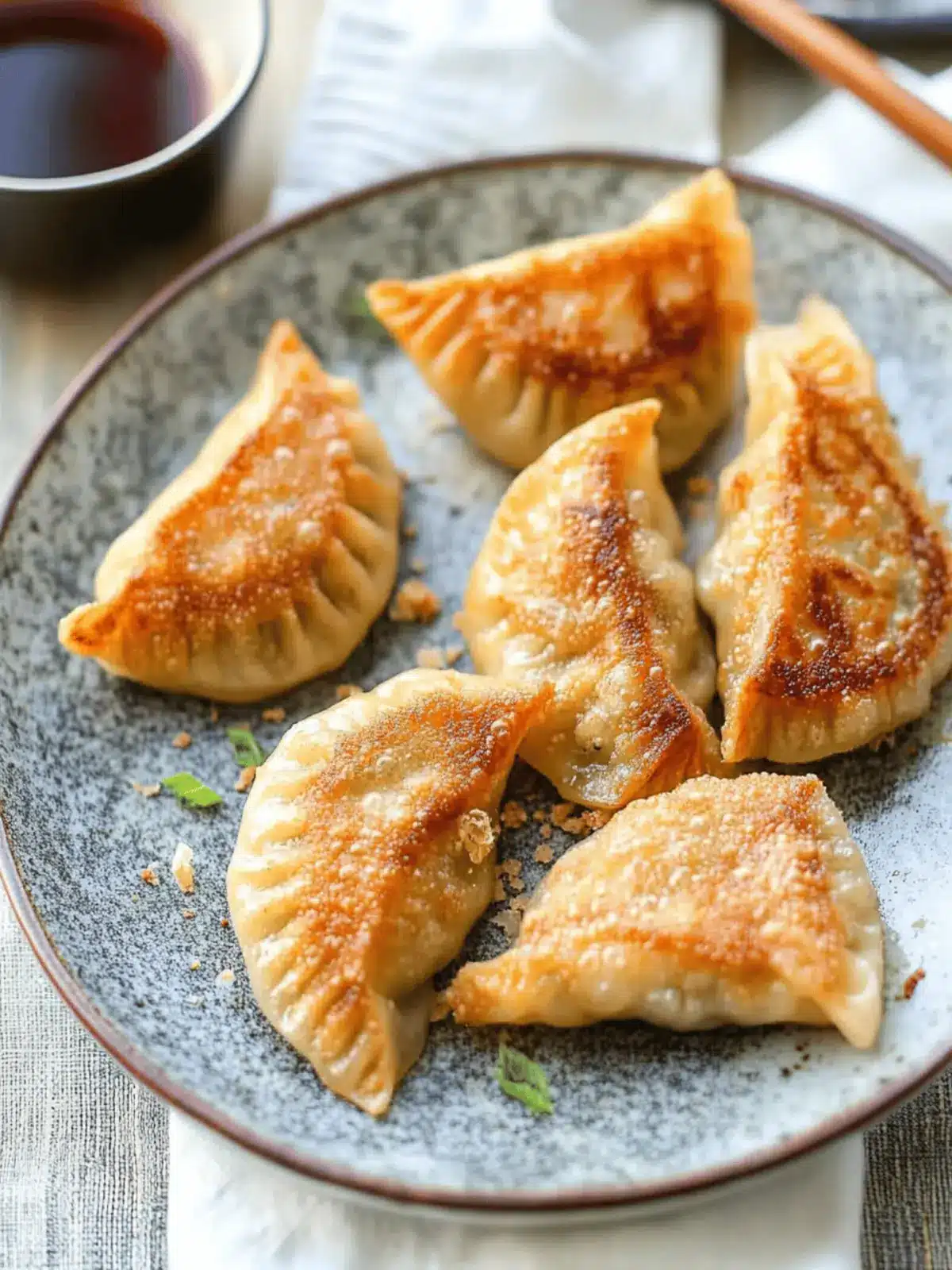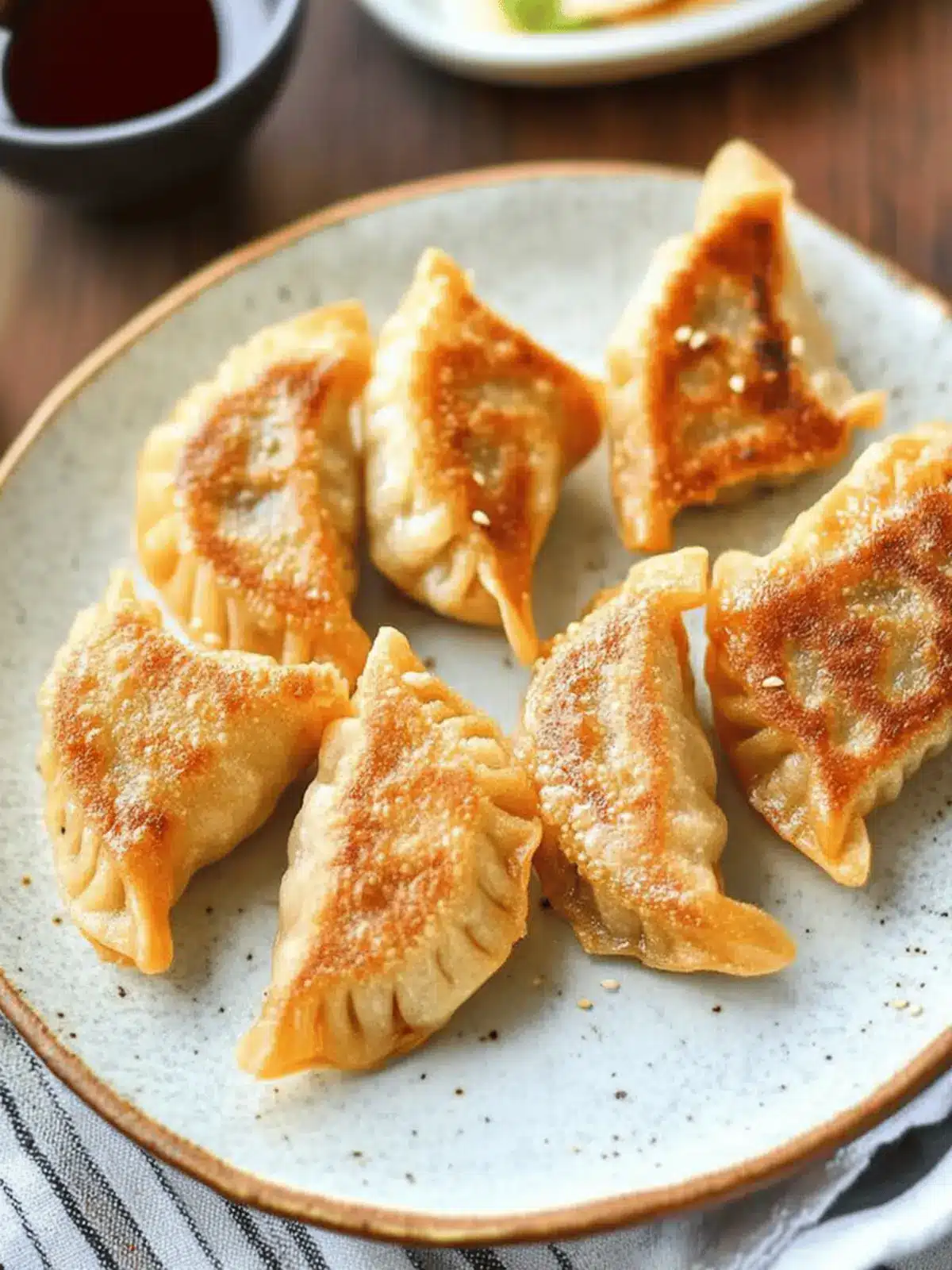The moment you bite into a freshly made mandu, you’ll understand why these Korean dumplings are a beloved staple in homes and restaurants alike. The tender wrappers cradle a medley of flavors that dance on your palate, whether you’re savoring a hearty pork filling or opting for a fresh, vegetable-packed version. I first learned to craft these delicious morsels during a cooking class, and my kitchen hasn’t been the same since.
Mandu is the perfect solution to that age-old dilemma: what to make that’s fast, easy, and impressively tasty. Loaded with customizable fillings, they can easily accommodate any dietary preference—from meaty delights to vibrant veggie options—making them an instant favorite for anyone who finds themselves craving something a bit more wholesome than takeout. Best of all, you can whip up a big batch, freeze the extras, and enjoy these comforting treats anytime you want. Ready to dive into the world of homemade mandu? Let’s get started!
Why love Mandu (Korean Dumplings)?
Versatile Delicacy: Mandu’s fillings are endlessly customizable—use pork, beef, or go vegetarian with vibrant veggies for every palate and preference.
Quick & Easy: This recipe is simple enough for weeknight dinners yet impressive for entertaining guests, ensuring you shine in the kitchen.
Freezer-Friendly: Make a big batch and freeze them for future meals, cutting down on cooking time while always having a delicious option ready.
Cultural Flair: Dive into a recipe steeped in tradition, celebrating the communal essence of Korean culture, perfect for sharing with loved ones.
Flavor Explosion: With a tender wrapper that holds a burst of savory filling, every bite delivers a delightful explosion of taste that will keep you coming back for more.
Mandu (Korean Dumplings) Ingredients
For the Wrappers
• Dumpling Skins/Wrappers – Use store-bought for convenience, or experiment with homemade for an authentic touch.
For the Filling
• Zucchini (8 oz) – Adds moisture and a subtle flavor; can substitute with other vegetables like carrots.
• Green Cabbage (10 oz) – Provides crunch and sweetness; may substitute with napa cabbage.
• Fresh Mushrooms (4 oz, shiitake preferred) – Contributes umami richness; can swap with any available mushrooms.
• Onion (1/2 medium) – Offers sweetness and depth; shallots make a good alternative.
• Scallions (2) – Adds freshness; chives can be used if scallions are unavailable.
• Ground Pork (1/2 lb) or other meat – The primary protein source; swap for chicken, turkey, or tofu for a vegetarian option.
• Ground Beef (1/4 lb) – Intensifies flavor; omit or use more of another meat for a lighter alternative.
• Minced Garlic (1 tbsp) – Enhances overall flavor; garlic powder can serve in a pinch.
• Minced Ginger (1-2 tsp) – Infuses warmth and zest; can be omitted if desired.
• Soy Sauce (1 tbsp) – Provides necessary saltiness; try tamari or coconut aminos for a gluten-free substitute.
• Sesame Oil (1 tbsp) – Imparts nuttiness; vegetable oil can be used in a pinch.
• Egg (1) – Acts as a binder for the filling; omit for vegan, or use a flax egg as an alternative.
• Salt (1/4 tsp + more) – Essential to elevate the flavors of the filling.
• Pepper (1/8 tsp) – Adds a mild kick; feel free to adjust according to your heat preference.
Embrace the process, and soon you’ll be creating your very own signature mandu, showcasing not only your culinary skills but also the love and care that goes into every sumptuous bite!
How to Make Mandu (Korean Dumplings)
-
Prepare Vegetables: Finely chop the zucchini and green cabbage, sprinkle them with salt, and let them sit for 15 minutes to draw out moisture. Once ready, squeeze out any excess water for a better filling texture.
-
Mix Filling: In a mixing bowl, combine the prepared vegetables with the ground pork, ground beef, minced garlic, minced ginger, soy sauce, sesame oil, egg, salt, and pepper. Stir everything together until well mixed.
-
Fill Wrappers:Take a dumpling wrapper and place a teaspoon of the filling in the center. Wet the edges with a little water, then fold the wrapper over and seal tightly to ensure no filling escapes; repeat until all filling is used.
-
Cook Dumplings: Choose your preferred cooking method:
- Pan-Fried (Gun Mandu): Heat oil in a pan, fry until golden brown, then add water and cover to steam for about 3-5 minutes.
- Deep-Fried (Tuigin Mandu): Heat oil until hot, fry until golden and crispy.
- Steamed (Jjin Mandu): Place in a steamer and cook for about 10 minutes.
- Boiled (Mul Mandu): Boil in water until they float, then continue for another 1-2 minutes.
Optional: Serve with a tangy dipping sauce for extra flavor.
Exact quantities are listed in the recipe card below.
Expert Tips for Making Mandu
-
Filling Techniques: Start with a small amount of filling in each dumpling to prevent tearing the wrapper during sealing. It’s better to underfill than overfill!
-
Proper Sealing: Make sure to wet the edges of the wrappers thoroughly before sealing, ensuring a tight closure that keeps fillings from leaking.
-
Cooking Space: When pan-frying or deep-frying, be cautious about overcrowding the pan; leaving space allows mandu to cook evenly and prevents them from sticking together.
-
Flavor Testing: Always taste-test your filling before sealing all the dumplings. Microwave a small spoonful to ensure the seasoning is perfect for your palate.
-
Freezing Tips: Lay uncooked mandu on a tray in a single layer before transferring them to a freezer bag. This method prevents them from sticking together, making it easy to grab just what you need later.
-
Cooking Methods: Experiment with different cooking methods to find your favorite; pan-fried mandu offers crispiness, while steamed mandu provides a soft, fluffy bite—all delicious!
Storage Tips for Mandu (Korean Dumplings)
Room Temperature: Mandu should ideally be consumed fresh. If you want to leave them out, keep them in an airtight container at room temperature for no more than 2 hours to maintain quality.
Fridge: Cooked mandu can be stored in the refrigerator for up to 3 days. Place them in an airtight container to prevent them from drying out or absorbing odors.
Freezer: Uncooked mandu can be frozen for up to 3 months. Arrange the dumplings on a tray to freeze individually before transferring them to a freezer bag for easy access later.
Reheating: For reheating, steam or pan-fry them straight from the freezer for about 8-10 minutes until heated through. Enjoy your delicious mandu anytime!
What to Serve with Mandu (Korean Dumplings)?
Dinner just got a delightful upgrade with these savory dumplings, perfect for sharing and complementing with a variety of side dishes.
-
Tangy Dipping Sauce: A blend of soy sauce, vinegar, and spices enhances the mandu’s flavor, making each bite irresistible.
-
Crispy Pickled Vegetables: The crunch and acidity from pickled radishes or cucumbers provide a refreshing contrast to the richness of the dumplings.
-
Steamed Rice: A scoop of fluffy rice serves as a neutral base, balancing the savory flavors of the mandu and ensuring a satisfying meal.
-
Spicy Kimchi: The heat and umami of kimchi pair beautifully, adding depth to your meal while celebrating the traditional Korean flavors.
-
Miso Soup: A warm bowl of miso soup offers a comforting side that complements the texture of mandu while warming you from the inside out.
-
Crisp Salad: A light salad with cucumbers, carrots, and sesame dressing introduces freshness, enhancing the overall meal experience without being too heavy.
-
Craft Beer or Soju: Enjoying a chilled drink, like a light lager or traditional soju, alongside your mandu elevates your dining experience and pairs wonderfully with Korean cuisine.
Make Ahead Options
Mandu (Korean Dumplings) are perfect for busy home cooks looking to save time during hectic weeknights! You can prepare the filling up to 24 hours in advance by mixing all the filling ingredients and refrigerating them in an airtight container to prevent browning and maintain freshness. Furthermore, once you assemble the dumplings, they can be frozen for up to 3 months; simply lay them out on a tray to freeze individually before transferring to a freezer bag. When you’re ready to cook, boil, steam, or fry your frozen mandu directly from the freezer—no need to thaw! This way, you’ll always have delicious, homemade dumplings ready to enjoy with minimal effort.
Mandu Variations & Substitutions
Feel free to unleash your creativity and make this luscious dumpling recipe truly your own!
-
Vegetarian: Swap pork and beef for a mix of mushrooms, tofu, or lentils to create a hearty veggie version. The umami flavors from mushrooms will keep it savory and satisfying.
-
Gluten-Free: Use rice paper wrappers in place of traditional dumpling skins for a gluten-free alternative. They offer a delightful twist on the texture while still holding delicious fillings.
-
Spicy Kick: Add a teaspoon of gochujang or chopped chili peppers to your filling mix for a spicy explosion that complements the savory elements beautifully.
-
Herbaceous: Toss in fresh herbs like cilantro or Thai basil to brighten up the filling and make every bite refreshing and aromatic.
-
Savory Swaps: Experiment with different types of meat like turkey or duck. You could also try seafood by using shrimp or crab for a luxurious twist.
-
Creamy Texture: Incorporate cream cheese or ricotta into your filling to add a creamy depth of flavor. This works especially well for a unique take on classic mandu.
-
Fermented Flavor: Mix in finely chopped kimchi for an extra tangy and savory element that enhances the traditional taste of mandu, making it even more addictive!
-
Sweet Addition: For a sweet-savory filling, add a dash of sugar or finely chopped sweet potatoes. This provides a balanced flavor profile that turns these dumplings into a delightful treat!
Mandu (Korean Dumplings) Recipe FAQs
What type of wrapper should I use for mandu?
Absolutely! You can use store-bought dumpling skins for convenience, or if you’re feeling adventurous, making your own can offer an authentic touch. Homemade wrappers add a delightful chewiness, enhancing the overall experience of your mandu.
How do I store leftover mandu?
Very good question! Cooked mandu can be stored in an airtight container in the refrigerator for up to 3 days. Make sure they are cool before sealing to prevent moisture buildup. To reheat, simply steam or pan-fry them until heated through.
Can I freeze mandu for later use?
Yes, you can! To freeze uncooked mandu, lay them in a single layer on a baking tray until they’re firm, then transfer them into a freezer bag. This way, they won’t stick together, and you can grab just what you need later. They’ll be good for up to 3 months! When ready to cook, you can steam or fry them directly from the freezer.
What can I do if my dumpling wrappers keep tearing?
Don’t fret! If your wrappers are tearing, make sure you’re using fresh, pliable skins. Lightly moisten the edges before sealing—this helps create a better bond. Additionally, be cautious not to overfill; starting with a smaller amount of filling can prevent ruptures during cooking.
Are there any dietary considerations for mandu?
Absolutely! Mandu is versatile and can be easily adapted for various dietary needs. For a vegetarian version, substitute the meat with mushrooms, tofu, or a mix of your favorite vegetables. If you or someone in your household has gluten sensitivities, opt for gluten-free dumpling wrappers and ensure your soy sauce is tamari or coconut aminos.
What is the best way to know the filling is properly seasoned?
Great query! A simple trick is to microwave a teaspoon of the filling mixture for about 30 seconds and taste-test it. This way, you can adjust the seasoning before sealing all your dumplings. Ensuring your filling is well-seasoned will give the final dish an irresistible flavor boost!
Mandu (Korean Dumplings) Recipe FAQs

Master Mandu: Irresistible Korean Dumplings to Savor
Ingredients
Equipment
Method
- Finely chop the zucchini and green cabbage, sprinkle them with salt, and let them sit for 15 minutes to draw out moisture. Once ready, squeeze out any excess water for a better filling texture.
- In a mixing bowl, combine the prepared vegetables with the ground pork, ground beef, minced garlic, minced ginger, soy sauce, sesame oil, egg, salt, and pepper. Stir everything together until well mixed.
- Take a dumpling wrapper and place a teaspoon of the filling in the center. Wet the edges with a little water, then fold the wrapper over and seal tightly to ensure no filling escapes; repeat until all filling is used.
- Choose your preferred cooking method: Pan-Fried (Gun Mandu): Heat oil in a pan, fry until golden brown, then add water and cover to steam for about 3-5 minutes. Deep-Fried (Tuigin Mandu): Heat oil until hot, fry until golden and crispy. Steamed (Jjin Mandu): Place in a steamer and cook for about 10 minutes. Boiled (Mul Mandu): Boil in water until they float, then continue for another 1-2 minutes.
- Serve with a tangy dipping sauce for extra flavor.








